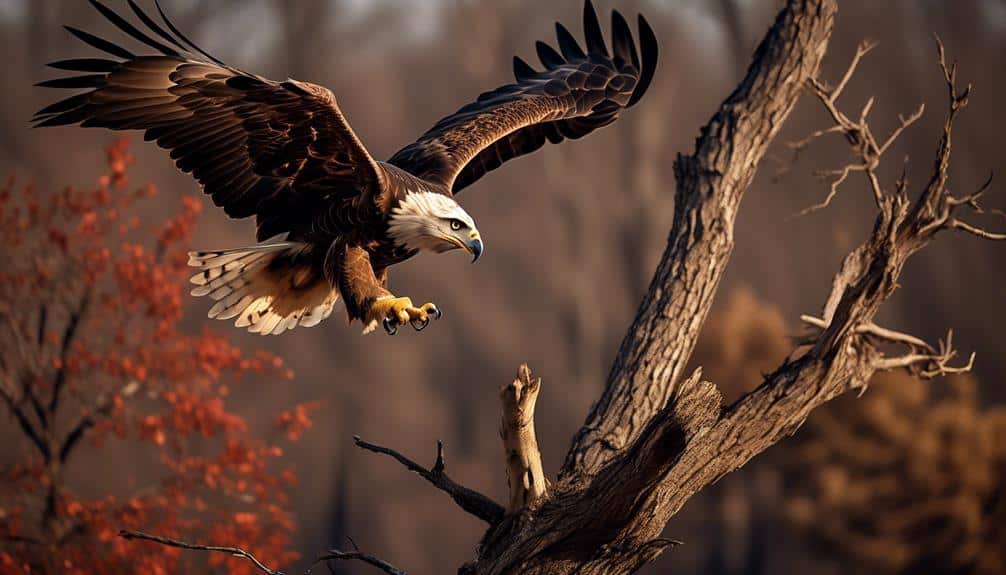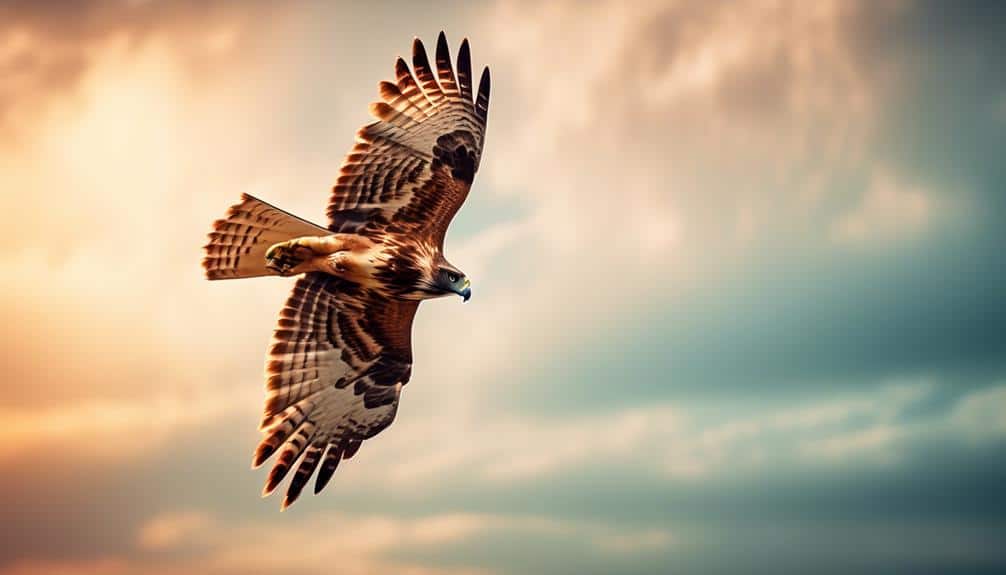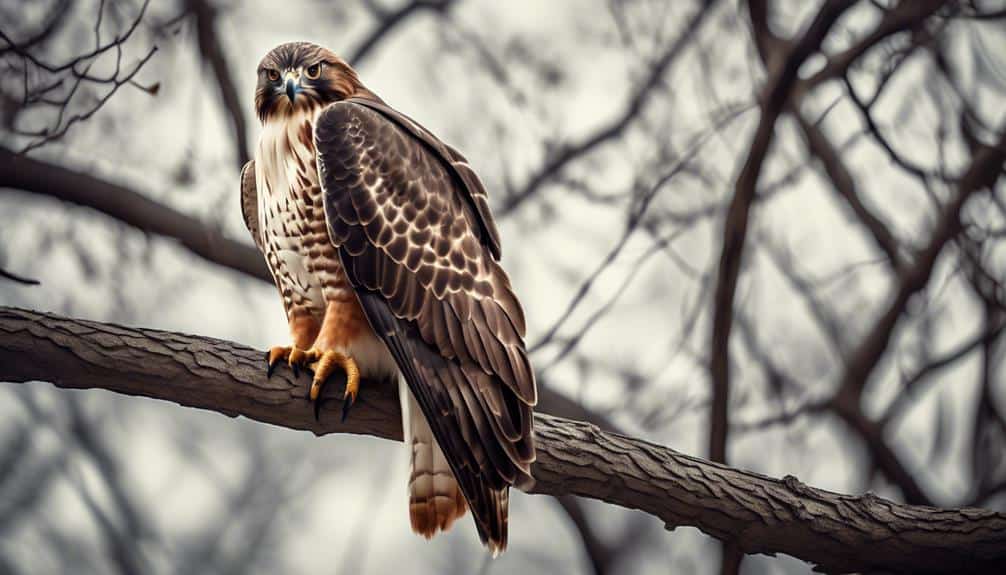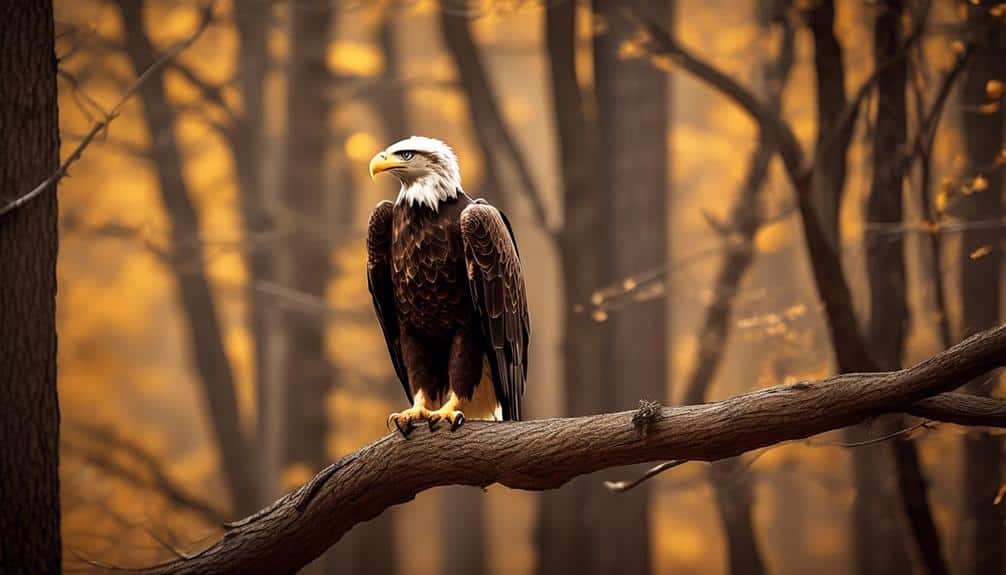Did you know that Illinois is home to over 20 species of birds of prey? These magnificent creatures play a crucial role in maintaining the delicate balance of our ecosystem.
From the majestic Bald Eagle to the agile Red-tailed Hawk, the diverse array of birds of prey found in Illinois is truly fascinating.
But what sets them apart? What are their unique characteristics and behaviors?
Join me as we explore the captivating world of Illinois birds of prey and uncover the secrets of these remarkable creatures.
Types of Illinois Birds of Prey

There are several types of birds of prey that can be found in Illinois. These majestic creatures are known for their incredible hunting techniques and impressive migration patterns. Let's delve into the fascinating world of Illinois birds of prey.
One prominent bird of prey in Illinois is the Red-tailed Hawk (Buteo jamaicensis). With its keen eyesight and powerful talons, this species employs various hunting techniques, such as soaring high above open fields to spot small mammals or perching on elevated structures to ambush prey.
Another remarkable bird of prey is the Northern Harrier (Circus hudsonius). This species utilizes a unique hunting technique known as 'owl-like' flight, where it glides low to the ground, searching for small mammals in open grasslands.
When it comes to migration patterns, Illinois serves as an important stopover for many birds of prey. During their annual migration, these birds travel long distances to reach their breeding grounds or wintering areas. Species like the Broad-winged Hawk (Buteo platypterus) and the Osprey (Pandion haliaetus) undertake remarkable journeys, crossing vast distances and even navigating through obstacles like the Great Lakes.
Understanding the hunting techniques and migration patterns of Illinois birds of prey helps us appreciate the ecological significance of these magnificent creatures. Their presence in Illinois is a testament to the state's diverse and rich avian biodiversity.
Characteristics of Illinois Birds of Prey

As we explore the fascinating world of Illinois birds of prey, it's important to understand the distinguishing characteristics that make these majestic creatures unique.
Birds of prey in Illinois have various adaptations for hunting, which enable them to excel in capturing their prey. Their sharp, curved beaks and powerful talons are specialized tools for grasping and tearing apart their food. Additionally, their exceptional eyesight allows them to spot potential prey from great distances. This, combined with their ability to hover in mid-air, gives them an advantage when hunting in open fields or wooded areas.
Reproduction and nesting habits of Illinois birds of prey also contribute to their distinct characteristics. These birds typically mate for life and establish nesting territories. They construct large nests, often located in trees or on rocky ledges, where they lay their eggs. The female is primarily responsible for incubating the eggs, while the male provides food for both the female and the chicks. Once the eggs hatch, the parents tirelessly feed and care for the young until they're ready to leave the nest and begin their own lives.
Understanding these characteristics of Illinois birds of prey helps us appreciate the incredible adaptations and behaviors that make them such formidable hunters and devoted parents in their natural habitats.
Habitats of Illinois Birds of Prey

Illinois birds of prey can be found in a variety of habitats throughout the state, adapting to their surroundings for optimal hunting and nesting opportunities. These habitats provide the necessary resources for their survival and reproduction.
Here are some key habitats where Illinois birds of prey can be found:
- Forests: Many birds of prey in Illinois, such as the Red-tailed Hawk and the Great Horned Owl, prefer nesting in large trees found in forested areas. These habitats offer ample protection and concealment for their nests and young.
- Grasslands: Open grasslands provide ideal hunting grounds for birds of prey such as the Northern Harrier and the American Kestrel. Their hunting techniques involve low-level flights over the grass, where they can swoop down on unsuspecting prey.
- Wetlands: Wetland habitats, including marshes and swamps, attract birds of prey like the Osprey and the Bald Eagle. These birds rely on fishing as their primary hunting technique, diving into the water to catch fish.
Birds of prey in Illinois have adapted to these diverse habitats, utilizing different nesting sites and employing various hunting techniques. Understanding the habitats they inhabit is crucial for conservation efforts and ensuring their continued presence in the state.
Behaviors of Illinois Birds of Prey

When observing the behaviors of birds of prey in Illinois, one can witness their remarkable hunting strategies and nesting rituals. These majestic creatures have evolved unique hunting techniques that allow them to effectively capture their prey.
One such technique is known as soaring, where birds such as hawks and eagles use air currents to glide effortlessly above the ground, scanning for potential meals. Once a target is spotted, they'll swiftly dive down with incredible speed and accuracy, using their sharp talons to snatch their prey.
Another hunting technique employed by birds of prey is called stooping. This involves the birds descending rapidly from a higher vantage point, surprising their unsuspecting prey with a sudden attack.
In addition to their hunting techniques, the breeding habits of Illinois birds of prey are also fascinating to observe. Most birds of prey in Illinois are monogamous, forming lifelong pair bonds. They engage in elaborate courtship displays, which often involve aerial acrobatics and vocalizations.
Once the pair has successfully mated, they'll begin constructing their nest, known as an eyrie. These nests are typically built high up in trees or on cliff ledges, providing a safe haven for their offspring. Both parents take turns incubating the eggs and caring for the young, ensuring their survival and development.
Conservation of Illinois Birds of Prey

The conservation of Illinois birds of prey is a crucial endeavor aimed at preserving and protecting these majestic creatures and their unique habitats. To ensure the survival of these birds, it's essential to understand the threats they face and the efforts being made to conserve them.
Threats to the conservation of Illinois birds of prey include habitat loss, pollution, and human disturbance. As urbanization and agricultural expansion continue, the natural habitats of these birds are being fragmented and destroyed. Pollution, such as pesticides and heavy metals, can accumulate in their food chain, affecting their reproductive success and overall health. Human disturbance, including disturbance at nesting sites and illegal hunting, also poses a significant threat to their survival.
Conservation efforts for Illinois birds of prey focus on habitat preservation, education, and research. Land conservation programs aim to protect and restore critical habitats for these birds, ensuring they have suitable nesting and foraging areas. Educational initiatives raise awareness about the importance of these birds and promote responsible behavior towards them. Research projects help gather valuable data on their populations, migration patterns, and behavior, aiding in their conservation.
Frequently Asked Questions
How Do Illinois Birds of Prey Communicate With Each Other?
Birds of prey in Illinois communicate through vocalizations and body language. They use a variety of calls, such as screeches and hoots, to convey messages to their conspecifics. Feathers also play a crucial role in communication, as they can be used to display aggression or attract mates.
What Is the Lifespan of Illinois Birds of Prey?
Longevity and breeding patterns are key aspects in studying the lifespan of birds of prey. By examining their reproductive behaviors and survival rates, we can gain insights into the fascinating world of these majestic creatures.
Are Illinois Birds of Prey Affected by Climate Change?
Climate change impacts birds of prey by altering their habitats, prey availability, and migration patterns. To cope, they may adapt by shifting their ranges, changing foraging behaviors, or adjusting breeding patterns.
How Do Illinois Birds of Prey Hunt for Their Prey?
Illinois birds of prey use a variety of hunting techniques to catch their prey. They employ keen eyesight, soaring in the sky to detect potential prey, and then use their sharp talons and powerful beaks to capture and kill their prey.
Can Illinois Birds of Prey Be Kept as Pets?
Keeping birds of prey as pets is not recommended due to legal requirements and the specialized care they require. Birds of prey are wild animals that need large spaces to fly and hunt, making them unsuitable for domestication.
Conclusion
In conclusion, Illinois is home to a diverse range of birds of prey, including species such as the bald eagle, red-tailed hawk, and great horned owl.
These majestic creatures play a vital role in maintaining the balance of our ecosystem by controlling rodent populations and serving as indicators of environmental health.
One fascinating statistic is that the bald eagle population in Illinois has increased by over 400% in the past decade, a testament to successful conservation efforts.





